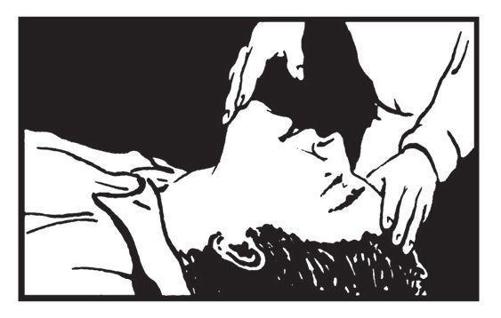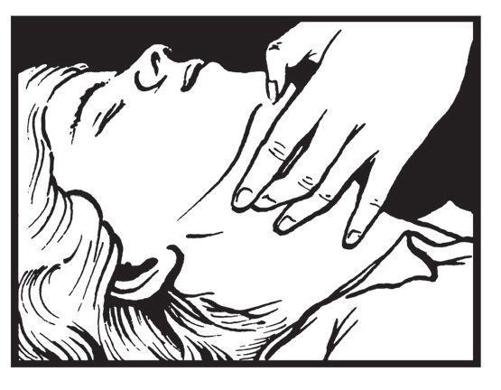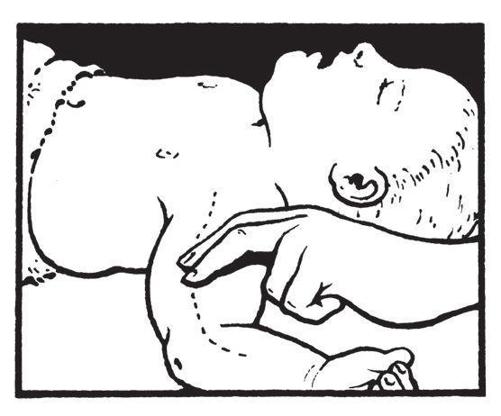SAS Urban Survival Handbook (130 page)
Read SAS Urban Survival Handbook Online
Authors: John Wiseman
Tags: #Health & Fitness, #Reference, #Survival, #Fiction, #Safety, #Self-Help, #Personal & Practical Guides, #General, #Survival Skills

There are many cases where prompt action can prevent worsening of an injury, ease discomfort and sometimes even save a life. In cases of cardiac arrest, or when breathing has stopped or when it is impaired, first aid can be of vital importance, if administered properly while waiting for an ambulance to arrive.
EVERYONE should have a knowledge of basic first-aid procedures so that they are equipped to deal with any emergency. Take a course and learn how to do it properly. No book can compete with qualified people in terms of demonstrating the correct techniques and procedures.
The techniques given here should enable you to provide urgent help in emergencies in the city.

BE AN EXPERT!
Do YOU know how to apply first aid—even just the basics? WHY NOT? It is absolutely ESSENTIAL that one person in every home and one person in every department of every workplace knows how to deal with medical emergencies. Don’t be the parent or the friend who watches helplessly while a loved one dies.
Further danger?
Once the immediate threat to life has been dealt with and emergency medical assistance is on its way, it is YOUR responsibility to reduce any further threat/danger to the victim or yourself. Under most circumstances you should try NOT to move or carry the victim—you may cause further injury to the victim and to yourself.
It may be essential to move him/her away from a source of danger—a fire or a collapsing building. In the case of a road accident, stop the traffic—if the victim is inside a vehicle, ONLY move them if there is the threat of further injury from fire or explosion.
Post-traumatic stress
After any accident, attack, injury or extremely stressful event in a person’s life, there may be a period of anxiety, fear or depression. It may begin immediately, or over a period of months—often as the person ‘relives’ the event in their mind. YOU can lessen the trauma at the onset—reducing the embarrassment, fear and panic of a casualty during the event by giving as much caring reassurance as possible. Hold a hand. Stroke a forehead.
REMEMBER
DON’T PANIC
Panic affects judgement and coordination. Stay calm, you may need to give the casualty constant reassurance. Knowledge of first aid is itself an antidote to panic.
IMPROVISE
You can’t prepare for every emergency and each requires a different response. Be ready to use a T-shirt to control heavy bleeding or an ordinary credit card to close a sucking wound over a punctured lung until medical help arrives.
ASSESS RISKS
Consider the dangers of each possible course of action. Choose the one you believe to be the best.
If there are other people who can help, send someone to call an ambulance while you give the casualty urgent aid. Tell them what to say so that the emergency service know what to expect when they arrive and will have things ready to help the casualty’s needs. If there are more people than are needed to help, send them away. Crowding round can increase the casualty’s distress and obstruct emergency services when they arrive. If you witness an accident and see the injured are already being well-cared for, move on. Don’t get in the way.
If you suspect that the casualty may have a disease and that there is a risk of infection, protect yourself by wearing gloves or putting your hands into plastic bags. The AIDS crisis has made people very frightened of coming into contact with other people’s blood. If someone is bleeding severely, you MUST do something!

WARNING
NEVER induce vomiting, unless you are absolutely certain that the casualty has swallowed barbiturates/tranquillizers/poisonous plant material very recently.
NEVER use tourniquets.
NEVER remove large pieces of glass or metal from a wound.
NEVER give up. Always do all you can to help and wait for medical help before assuming that someone is dead—drowning victims can sometimes be resuscitated for 25 minutes after being presumed dead.
Do everything you can to keep ‘onlookers’ away. You may need help to care for a casualty and you WILL need someone to call an ambulance. DON’T permit people to crowd round a casualty, particularly if they are saying things like: ‘Is he dying?’, ‘Isn’t she bleeding a lot!’ and, appallingly thoughtless as it may seem, ‘Look, her foot’s come off’.
Often called ‘shock’, this post-traumatic stress may need to be treated by support and counselling as part of general aftercare.
First-aid kit
Normally a small first-aid kit is intended for minor accidents, but equip yours to be able to apply first aid to more serious injuries. Keep it in a sealed plastic container, out of reach of children and in a cool dry place. Your kit should contain:
- ◑ Antiseptic lotion and antiseptic wipes
- ◑ Cotton wool for cleaning wounds—NEVER use cotton wool or any ‘fluffy’ fabric as a dressing. Even a clean T-shirt or a pad of clean lavatory paper would do in an emergency
- ◑ Blunt-ended scissors for cutting bandages/dressings
- ◑ Painkillers such as aspirin/paracetamol—NEVER exceed the stated dosage
- ◑ Antihistamine cream for insect stings/bites
- ◑ Thermometers (oral and rectal)
- ◑ Tweezers to remove large splinters
- ◑ Eyebath/eyewash solution
- ◑ Adhesive dressings for small cuts and grazes
- ◑ Roll of fabric adhesive tape
- ◑ Triangular bandage and safety pins for making slings
- ◑ Sterile dressing for covering wounds
- ◑ Sterile eye dressing and bandages for eye injuries
- ◑ Crepe bandages for sprains and wounds in awkward places such as elbows/knees/ankles
- ◑ Tubular gauze bandages and applicator tongs for wholefinger dressings
FIRST AID
You are in an emergency first-aid situation, an ambulance has been called and it’s on its way, but do you know what to do next and shouldn’t you be doing it already? The concept of saving a person’s life may seem daunting but, in fact, life can often be sustained by a few simple procedures.
The instructions given in this chapter may seem complex, but to save a life all a casualty needs is an unobstructed airway with adequate breathing AND blood circulation. It’s that simple. Knowing this helps to work out when a first-aid situation is life-threatening.
You must act at once if a casualty has stopped breathing, their heart has stopped beating or if they are bleeding severely. If they are unconscious, the airway may become blocked and they may suffocate. In any more serious first-aid situation, your first priority is to check the casualty’s vital functions:
Open airway
A blocked or obstructed airway can be caused by a foreign body—such as food or vomit—or by a constriction of the air passage—often as a result of unconsciousness and by the tongue itself (which can fall back inside the mouth). To check, with the casualty on their back:
Lift up casualty’s jaw to dislodge tongue, tilting the head back. If breathing is heavy or noisy, check if there is any blockage in the mouth. Sweep a finger around inside, but DON′T push any matter back into the throat. Place casualty in RECOVERY POSITION ☛

Check breathing
If casualty is unconscious, detecting breathing can be difficult—use your eyes, ears and touch. Hold victim’s airway open as in ☜ OPEN AIRWAY and place your ear over mouth and nose. Look at line of victim’s chest for any movement, while listening. Feel for breath on your cheek.
Pulse
The heart pumps blood around the body, so it is VITAL to know whether this function is still being carried out. Putting your ear to the chest and listening will not always work—feeling for blood flow in arteries just below the skin, a pulse, will. To check:
The most reliable pulse can be felt at the neck—the carotid pulse. Turn face to one side. Slide fingers from voice box into depression alongside and press gently.

With a baby check brachial pulse, located on inside of upper arm midway between shoulder and elbow. Press index and middle fingertips lightly towards bone.

Check bleeding
Major external bleeding will be obvious, but a dramatic loss in body fluid (including blood) may not be apparent if the injury is internal. Check for:
- ◑ Pale/grey skin, particularly in and around lips
- ◑ Cold skin
- ◑ Shallow/rapid breathing
- ◑ Weak/rapid pulse
- ◑ If victim is unconscious, clear airway and treat for SEVERE BLEEDING/SHOCK ☞
INTO ACTION!